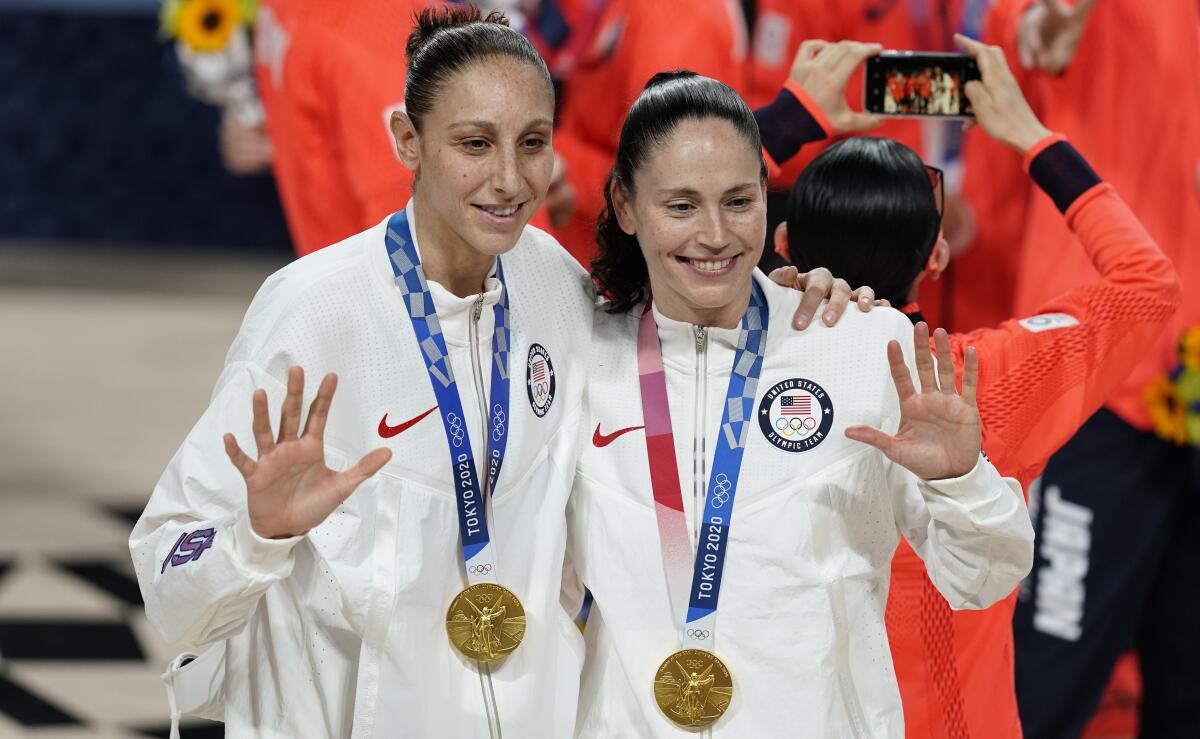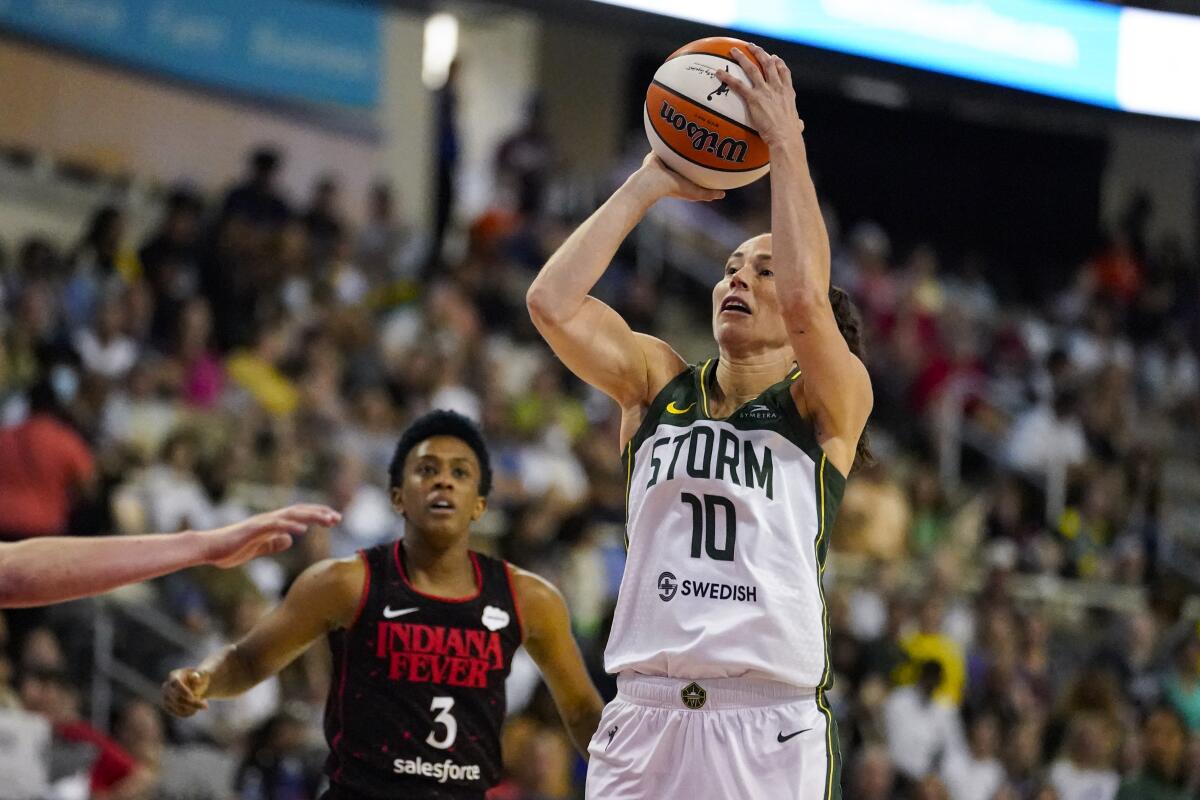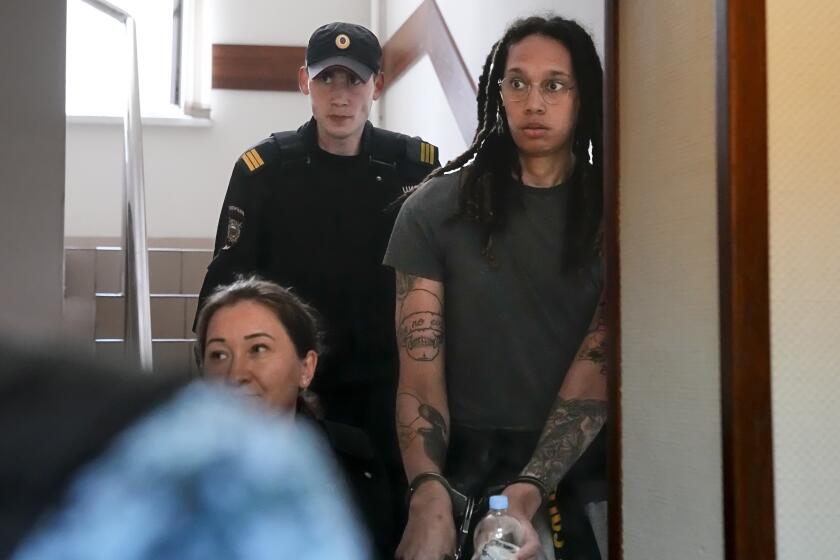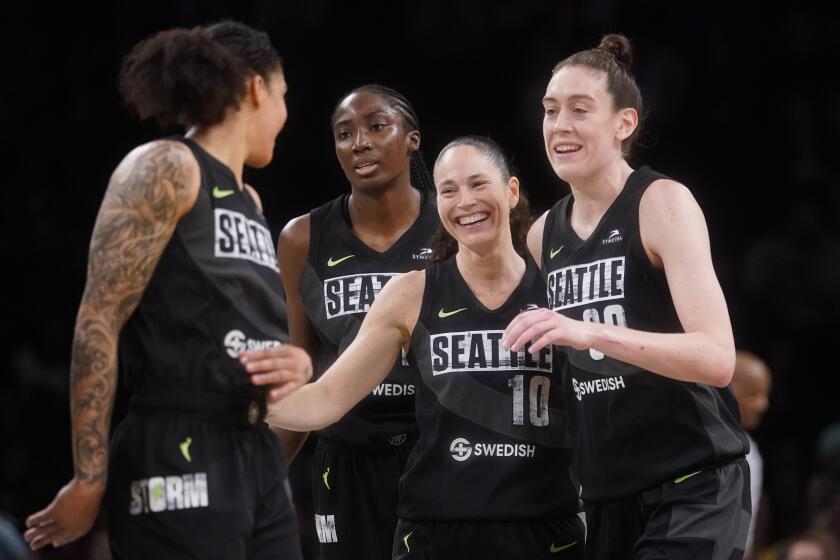What is the Commissioner’s Cup? How Sue Bird contributed to the new WNBA event

- Share via
A basketball wearing a crown, a second table of standings and half a million dollars mark what the WNBA hopes is its next big thing.
The Commissioner’s Cup is an in-season tournament meant to rally fans through cross-conference rivalries and boost revenue opportunities for the WNBA. You would be forgiven if you haven’t taken notice in its two-year existence. Some players are caught forgetting. But for a history of the WNBA’s newest vocabulary word, look no further than Sue Bird.
The Seattle point guard, Sparks forward Nneka Ogwumike and Mercury star Diana Taurasi were masterminds behind the WNBA’s latest innovation by pushing for the unique event during the 2019 collective bargaining agreement negotiations. A year after the Commissioner’s Cup debuted in the WNBA, the NBA is now considering an in-season tournament to spice up its regular season.
For Bird, the growth of the new event is just another contribution to her long list of game-changing achievements. The 41-year-old’s on-court accolades are nearly unmatched: five-time Olympic gold medalist, four-time WNBA champion, two-time NCAA champion, the WNBA’s winningest player and all-time leader in assists.
As the WNBA progresses, those records may one day fall. But Bird’s influence will last in her role as a key member of the players’ union who contributed innovative ideas to lay the foundation during a critical time for the WNBA’s growth.
Terri Jackson, the executive director of the Women’s National Basketball Players Assn., called Bird’s service as one of three union vice presidents “a gift.”
“She understood her responsibility to the game and to the women who are playing right now and the young women who are aspiring to be like her,” Jackson said. “We in the women’s game know what our role is and she understands her reach and her impact and quite honestly, she was tremendously generous these last few years in serving in leadership and sharing that with us.”
Brittney Griner sent heartbreaking letter to President Biden from a Russian prison pleading for her freedom. Her teammates worry no one is listening.
Bird, who announced her retirement at the end of the season last month, will play her final regular-season game against the Sparks on Thursday at Crypto.com Arena. It will be the last Commissioner’s Cup game of the year for both teams, who are already out of the race to get the $500,000 in bonus money, as players and fans continue to celebrate Bird’s illustrious career.
“Sue’s one of the GOATs,” said Sparks guard Jordin Canada, who played with Bird for four years in Seattle. “She’s a legend in this game. ... It’s a long list of things she has accomplished in her career and it’s just a testament to how great of a player she is, but not only that, but the person she is.”
Looking back on her 21-year WNBA career, Bird regrets not being more involved in the players’ union earlier, she told The Times in a phone interview. Like many of her peers, Bird spent her WNBA offseasons playing overseas. It felt like “out of sight, out of mind,” she said.
After Bird stopped playing overseas in 2015, she became more curious about the union. She began as a player rep. First vice president Layshia Clarendon encouraged Bird to run for a position on the executive committee.
It couldn’t have come at a better time. As Bird’s vice-presidential term began in August 2018, players were deciding whether to opt-out of their collective bargaining agreement.
Helping negotiate the 2020 CBA that was hailed for increased salaries and better benefits such as 100% paid maternity leave and stipends for childcare and family planning has been one of the most rewarding parts of being in player leadership, Bird said, along with the WNBA’s social justice campaigns during the 2020 bubble season that spotlighted Breonna Taylor and launched a campaign to elect Democratic senator Raphael Warnock.
The CBA negotiations were difficult, in part, because the players wanted to start from scratch after previous collective bargaining agreements left them feeling “stuck,” Bird said. Jackson said the players put forward 75 proposals.
Both sides punched away at the list and there was a moment when players appeared to signal to the league they were ready to sign, Jackson remembered. Until Bird stepped in with a question: “But why?”
“Sue said OK, we’re close to the end, we’re going to be done with this, but we don’t want any what-ifs,” Jackson said. “We don’t want any regrets.”

Despite the months of negotiations, the agreement celebrated on “Good Morning America” in January 2020 is not perfect. Two years into the seven-year contract, questions about a prioritization clause that limits lucrative overseas opportunities starting next season have some players second-guessing. Players are still feuding with the league about travel accommodations, which include additional leg room, but no guaranteed charter flights.
The current deal expires in 2027.
“I joke this is the CBA before the CBA,” Bird said. “We needed one that was going to be a foundational CBA that could be a starting point for growth beyond.”
The major area for growth that could solve many of the league’s problems is revenue. The salary cap increased by about 30% in the latest CBA, but the agreement only granted 50-50 revenue sharing if the league reaches certain revenue growth targets from broadcast agreements, marketing partnerships and licensing deals.
Creating the Commissioner’s Cup was supposed to help the league get toward the goals. Jackson called it “the game within the game,” as Bird, Taurasi and Ogwumike wanted to provide a real solution to the repeated calls for a “new model.” Inspired by similar in-season tournaments in leagues overseas, the two-year-old format designates 10 regular-season games for each team as Cup games and the top team in each conference will play an additional game with $50,000 of bonus money at stake.
The first year’s tournament, which ended with Seattle routing the Connecticut Sun and Bird joking that the trophy weighs as much as the team’s bonus money, felt like an afterthought as players were slow to shift their focus from the traditional regular-season stakes.

Sparks forward Katie Lou Samuelson, who won the Commissioner’s Cup last year as a member of the Storm, said awareness is growing in the competition’s second season. But with a WNBA-record 36 regular-season games to play, the Cup isn’t always at the forefront of every player’s mind.
Part of the current form’s appeal is that there’s minimal disruption to an already difficult schedule. It only adds one more game for the two finalists. But the small scale has also yet to make real waves.
In-season tournaments are already successful overseas, including the top Spanish league in which Samuelson and Storm guard Jewell Loyd play for 10-time Queen’s Cup champions Perfumerías Avenida. The competition gathers the top eight teams in the 16-team league for a single-elimination weekend tournament. It can be grueling — three games in three days — but the hunt for a trophy and a bonus, along with city bragging rights have sustained the event’s popularity in Spain.
Loyd sees a future in which the Commissioner’s Cup could grow into a major spectacle as well.
“The biggest thing in the WNBA is how you market things,” the three-time All-Star said. “That’s a big part of it, understanding who you’re marketing to, how you market it, what’s it about.”
Captain Breanna Stewart first traded for her Seattle teammate Sue Bird and then Sparks forward Nneka Ogwumike in the WNBA All-Star draft on Saturday.
The Commissioner’s Cup is currently sponsored by Coinbase, and Bird hopes sponsorship opportunities grow to expand the event for more teams that meet in a single location to become “an event almost like a way we view a Women’s Final Four.
“Like an actual moment in time,” she continued, “an event that people want to be a part of.”
Bird raised the inaugural Commissioner’s Cup trophy last year but will soon slip to the background as she watches the league continue the tradition in its next era. Passing this torch will be another assist during her record-breaking career.
More to Read
Go beyond the scoreboard
Get the latest on L.A.'s teams in the daily Sports Report newsletter.
You may occasionally receive promotional content from the Los Angeles Times.









